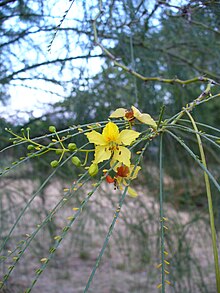Parkinsonia aculeata
| Parkinsonia aculeata | |
|---|---|

| |
| Flowers, leaves and pods | |
| Scientific classification | |
| Kingdom: | |
| (unranked): | |
| (unranked): | |
| (unranked): | |
| Order: | |
| Family: | |
| Genus: | |
| Species: | P. aculeata
|
| Binomial name | |
| Parkinsonia aculeata | |
Parkinsonia aculeata is a species of flowering tree in the pea family, Fabaceae. Common names include Mexican Palo Verde, Parkinsonia, Jerusalem Thorn, and Jellybean Tree. It is native to the southwestern United States (western Texas, southern Arizona), Mexico, the Caribbean, South America south to northern Argentina, and the Galápagos Islands.[1]
It grows 2 to 8 m (6.6 to 26.2 ft) high. The leaves and stems are hairless. The flattened petiole is edged by two rows of 25–30 tiny oval leaflets; the leaflets are soon deciduous in dry weather, leaving the green petioles and branches to photosynthesize. The branches grow sharp spines 7–12 mm (0.28–0.47 in) long. The flowers are yellow and fragrant, 20 mm (0.79 in) in diameter, growing from a long slender stalk in groups of eight to ten. The fruit is a seedpod, leathery in appearance, light brown when mature.
Invasive problems
P. aculeata is a major invasive species in Australia, parts of tropical Africa, Hawaii, and other Islands in the Pacific Ocean.
It was introduced to Australia as an ornamental tree and for shade around 1900. It is now a serious weed widespread through Western Australia, the Northern Territory and Queensland, covering about 8,000 km2 (3,100 sq mi) of land, and has the potential to spread through most of the semi-arid to subhumid tropical area in Australia.
It forms dense thickets, preventing access for humans, native animals and livestock to waterways. The seedpods float, and the plant spreads by dropping pods into water, or pods are washed downstream by seasonal flooding.
Several control methods are used to reduce the existing population and the spread of P. aculeata in Australia. Three insects have been introduced to Australia for biological control; the parkinsonia bean weevils, Penthobruchus germaini and Mimosestes ulkei, both have larvae that specifically eat the seeds from parkinsonia pods and are proving to be a useful management tool, and the parkinsonia leaf bug, Rhinacloa callicrates, which destroys photosynthetic tissues but has had no impact on the weed. Fire is effective for young trees; mechanical removal and herbicides are also used.
References
- ^ a b "Parkinsonia aculeata L." Germplasm Resources Information Network. United States Department of Agriculture. 1998-04-28. Retrieved 2009-11-28.
- Cooperative Centre for Weed Management. Weed of the month - Parkinsonia aculeata, April 2005
- QLD Dept of Natural Resources and Mines, Land Protection. 2004. NRM facts pest series: Parkinsonia
- Pacific Island Ecosystems at Risk: Parkinsonia aculeata
External links
![]() Media related to Parkinsonia aculeata at Wikimedia Commons
Media related to Parkinsonia aculeata at Wikimedia Commons
- "Parkinsonia aculeata" (PDF). Digital Representations of Tree Species Range Maps from "Atlas of United States Trees" by Elbert L. Little, Jr. (and other publications). United States Geological Survey.
- Parkinsonia
- Plants described in 1753
- Invasive plant species
- North American desert flora
- Flora naturalised in Australia
- Trees of Argentina
- Trees of Arizona
- Trees of Texas
- Trees of Baja California
- Trees of Baja California Sur
- Trees of Bolivia
- Trees of Ecuador
- Trees of Paraguay
- Trees of Peru
- Trees of Uruguay
- Flora of the U.S. Rio Grande Valleys
- Trees of Sonora
- Trees of Sinaloa
- Trees of Chihuahua
- Trees of Coahuila
- Trees of Nuevo León
- Trees of Tamaulipas
- Flora of the Sonoran Deserts
- Flora of the Chihuahuan Desert
- Mexican Plateau
- Trees of Mexico
